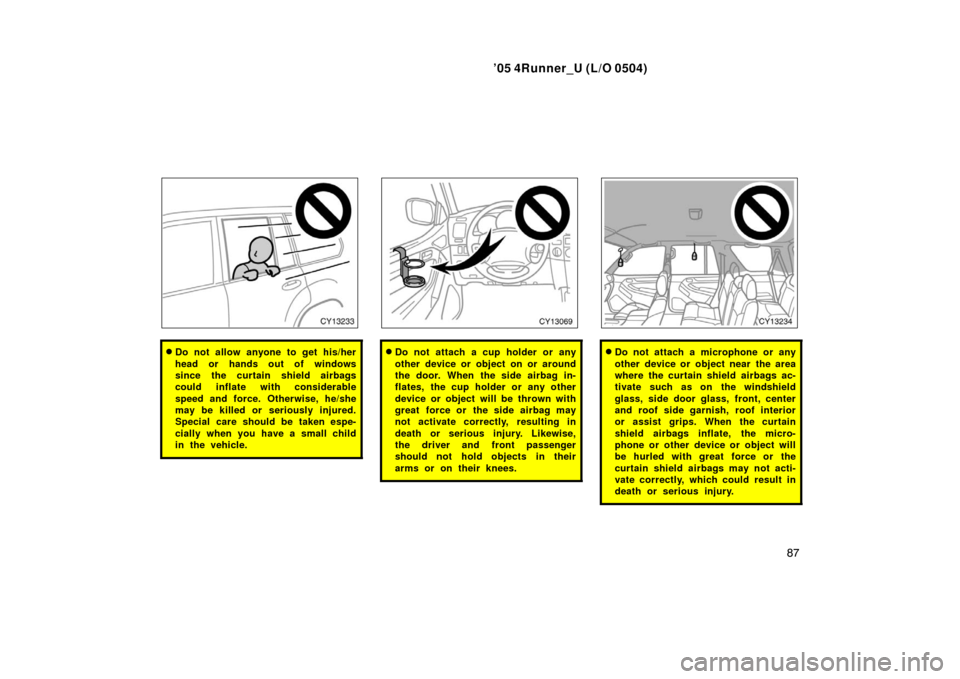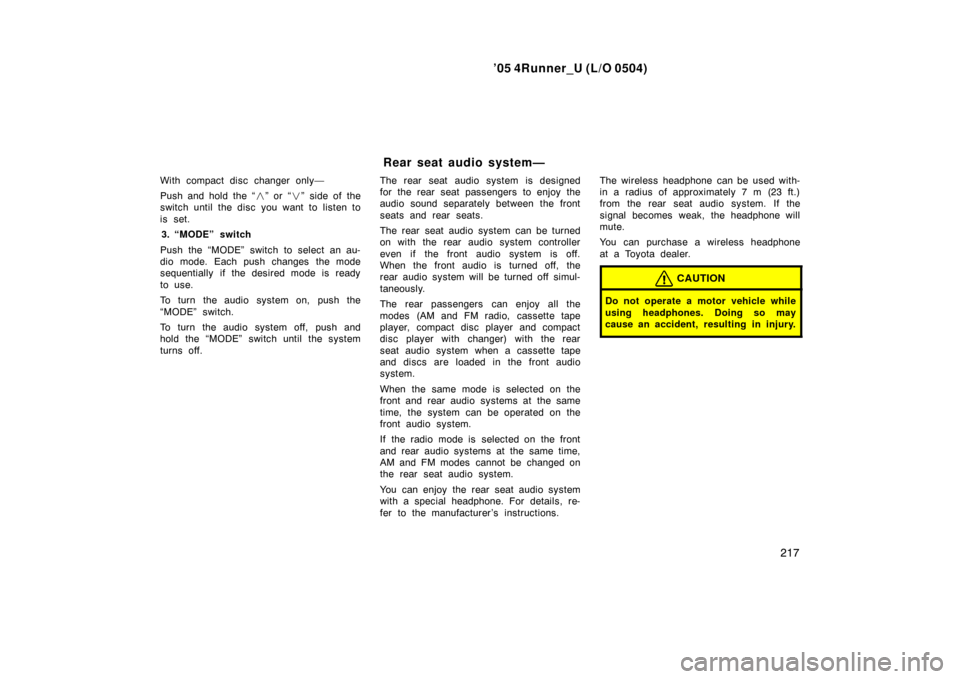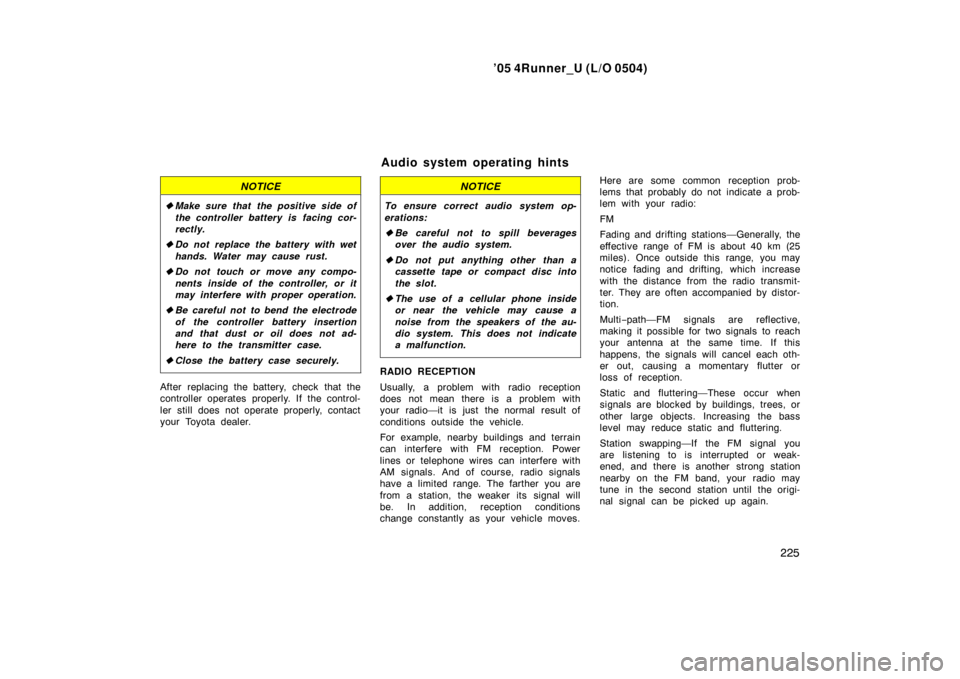Page 97 of 426

’05 4Runner_U (L/O 0504)
87
�Do not allow anyone to get his/her
head or hands out of windows
since the curtain shield airbags
could inflate with considerable
speed and force. Otherwise, he/she
may be killed or seriously injured.
Special care should be taken espe-
cially when you have a small child
in the vehicle.�Do not attach a cup holder or any
other device or object on or around
the door. When the side airbag in-
flates, the cup holder or any other
device or object will be thrown with
great force or the side airbag may
not activate correctly, resulting in
death or serious injury. Likewise,
the driver and front passenger
should not hold objects in their
arms or on their knees.�Do not attach a microphone or any
other device or object near the area
where the curtain shield airbags ac-
tivate such as on the windshield
glass, side door glass, front, center
and roof side garnish, roof interior
or assist grips. When the curtain
shield airbags inflate, the micro-
phone or other device or object will
be hurled with great force or the
curtain shield airbags may not acti-
vate correctly, which could result in
death or serious injury.
Page 227 of 426

’05 4Runner_U (L/O 0504)
217
With compact disc changer only—
Push and hold the “� ” or “�” side of the
switch until the disc you want to listen to
is set.
3. “MODE” switch
Push the “MODE” switch to select an au-
dio mode. Each push changes the mode
sequentially if the desired mode is ready
to use.
To turn the audio system on, push the
“MODE” switch.
To turn the audio system off, push and
hold the “MODE” switch until the system
turns off. The rear seat audio system is designed
for the rear seat passengers to enjoy the
audio sound separately between the front
seats and rear seats.
The rear seat audio system can be turned
on with the rear audio system controller
even if the front audio system is off.
When the front audio is turned off, the
rear audio system will be turned off simul-
taneously.
The rear passengers can enjoy all the
modes (AM and FM radio, cassette tape
player, compact disc player and compact
disc player with changer) with the rear
seat audio system when a cassette tape
and discs are loaded in the front audio
system.
When the same mode is selected on the
front and rear audio systems at the same
time, the system can be operated on the
front audio system.
If the radio mode is selected on the front
and rear audio systems at the same time,
AM and FM modes cannot be changed on
the rear seat audio system.
You can enjoy the rear seat audio system
with a special headphone. For details, re-
fer to the manufacturer ’s instructions.The wireless headphone can be used with-
in a radius of approximately 7 m (23 ft.)
from the rear seat audio system. If the
signal becomes weak, the headphone will
mute.
You can purchase a wireless headphone
at a Toyota dealer.
CAUTION
Do not operate a motor vehicle while
using headphones. Doing so may
cause an accident, resulting in injury.
Rear seat audio system—
Page 235 of 426

’05 4Runner_U (L/O 0504)
225
NOTICE
�Make sure that the positive side of
the controller battery is facing cor-
rectly.
� Do not replace the battery with wet
hands. Water may cause rust.
� Do not touch or move any compo-
nents inside of the controller, or it
may interfere with proper operation.
� Be careful not to bend the electrode
of the controller battery insertion
and that dust or oil does not ad-
here to the transmitter case.
� Close the battery case securely.
After replacing the battery, check that the
controller operates properly. If the control-
ler still does not operate properly, contact
your Toyota dealer.
NOTICE
To ensure correct audio system op-
erations:
�Be careful not to spill beverages
over the audio system.
� Do not put anything other than a
cassette tape or compact disc into
the slot.
� The use of a cellular phone inside
or near the vehicle may cause a
noise from the speakers of the au-
dio system. This does not indicate
a malfunction.
RADIO RECEPTION
Usually, a problem with radio reception
does not mean there is a problem with
your radio—it is just the normal result of
conditions outside the vehicle.
For example, nearby buildings and terrain
can interfere with FM reception. Power
lines or telephone wires can interfere with
AM signals. And of course, radio signals
have a limited range. The farther you are
from a station, the weaker its signal will
be. In addition, reception conditions
change constantly as your vehicle moves. Here are some common reception prob-
lems that probably do not indicate a prob-
lem with your radio:
FM
Fading and drifting stations—Generally, the
effective range of FM is about 40 km (25
miles). Once outside this range, you may
notice fading and drifting, which increase
with the distance from the radio transmit-
ter. They are often accompanied by distor-
tion.
Multi
−path—FM signals are reflective,
making it possible for two signals to reach
your antenna at the same time. If this
happens, the signals will cancel each oth-
er out, causing a momentary flutter or
loss of reception.
Static and fluttering—These occur when
signals are blocked by buildings, trees, or
other large objects. Increasing the bass
level may reduce static and fluttering.
Station swapping—If the FM signal you
are listening to is interrupted or weak-
ened, and there is another strong station
nearby on the FM band, your radio may
tune in the second station until the origi-
nal signal can be picked up again.
Audio system operating hints